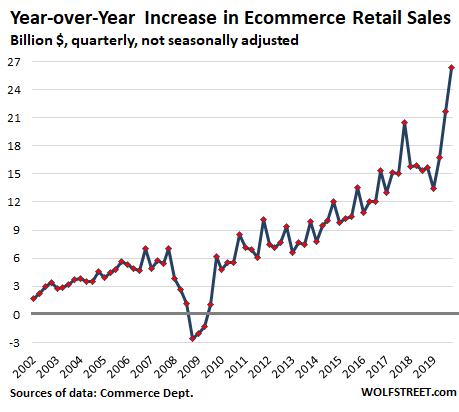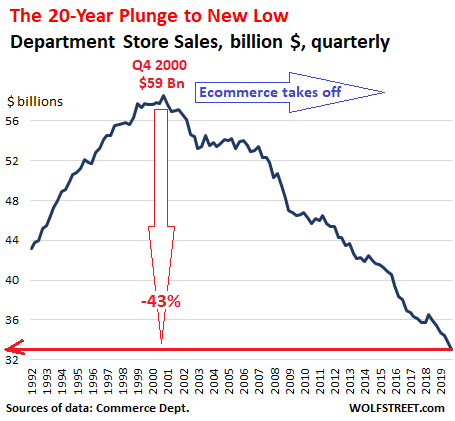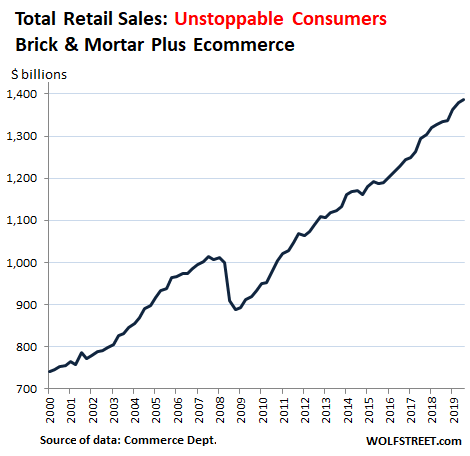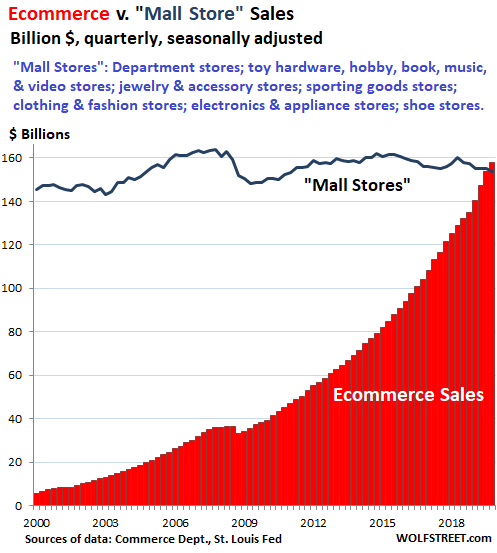What’s astounding many people: ecommerce growth is not leveling off, but keeps surging at blistering rates.
By Wolf Richter for WOLF STREET.
Ecommerce retail sales jumped 16.4% in the fourth quarter 2019 compared to a year earlier (not seasonally adjusted), to $187 billion, and reached $602 billion for the year, double the amount five years ago, according to the Commerce Department. Ecommerce retail sales in Q4 were $26.4 billion higher than in Q4 a year earlier, the biggest year-over-year dollar-gain in the history of ecommerce, as it continues to gain momentum, instead of losing it:

On a seasonally adjusted basis, ecommerce sales hit $154.5 billion in Q4 and accounted for 11.4% of total retail sales. But wait… retail sales include sales at gas stations (gasoline, diesel), auto dealers, and grocery and beverage stores. These three categories have largely been able to resist ecommerce – and they account for 55% of brick-and-mortar retail sales.
But the remaining 45% of brick-and-mortar sales are getting crushed and particularly the group of retailers that tend to populate shopping malls, including department stores: the “mall retailers,” as I call them.
Ecommerce sales include the online sales of brick-and-mortar retailers, many of which have built big and thriving online operations. According to eMarketer, these were the top 10 ecommerce retailers in 2019 – six of them started out as iconic US brick-and-mortar chains:
- Amazon
- eBay
- Walmart
- Apple
- Home Depot
- Best Buy
- Macy’s
- Qurate Retail Group (QVC, HSN, Zulily, Ballard Designs, Frontgate, Garnet Hill, and Grandin Road)
- Costco
- Wayfair (ecommerce furniture retailer)
Walmart belatedly got the memo a few years ago.
Walmart is now throwing everything it has at ecommerce to see what sticks, including ecommerce-related acquisitions, many of which didn’t stick. For 2019, it allocated $5.2 billion of its capital expenditures to building out its ecommerce infrastructure and technology, more than double what it allocated to spending on new stores and store remodels ($2.5 billion).
In its Q4 earnings report two days ago, it said that Walmart U.S. ecommerce sales had surged 37% year-over-year and that Sam’s Club ecommerce sales had surged 33%.
But Walmart, having gotten such a late start, remains woefully behind. In 2019, it started disclosing its ecommerce sales in dollars in its quarterly SEC filings, but hasn’t yet released it for Q4. Through the first three quarters of 2019 – so not including the huge holiday sales quarter – Walmart’s US ecommerce sales jumped 40% year-over-year to $14 billion. This indicates that its US ecommerce sales for the fiscal year 2019 were around $21 billion, which would be about 8.5% of its total US sales.
Other retailers are way ahead of Walmart.
Macy’s, when it announced in early February another 125 store closings, on top the prior waves of store closings, also disclosed that its ecommerce sales have surged to “more than $6 billion per year,” to over 25% of its total sales.
Nordstrom hasn’t yet released its SEC filings for fiscal Q4, but in its 10-Q for the third quarter, it disclosed that ecommerce sales had risen to 34% of total sales, on a 7% rise in ecommerce sales and a 7% drop in brick-and-mortar sales, for a 2% drop in overall sales.
Brick-and-mortar department stores – those that don’t want to go the route of Bon-Ton Stores, Sears Holdings, Barney’s, and soon J.C. Penney, among many regional chains – decided that they must seek salvation in ecommerce because ecommerce is wiping out department stores one by one, and chain by chain.
In Q4, sales at department stores dropped 6.6% year-over-year to just $33.1 billion (seasonally adjusted), having collapsed by 43% from their peak in Q4 2000 despite two decades of population growth and inflation.
This is the brick-and-mortar business Macy’s, Nordstrom, J.C. Penney, and Sears are in. It’s crazy to think that this can be turned around; the only thing department stores can do is slow down the decline at their stores while trying to migrate their business to ecommerce:

Total retail sales are just fine, thanks to ecommerce.
Including ecommerce, total retail sales in Q4 rose 3.9% year-over-year to $1.39 trillion, according to the Commerce Department’s revised retail trade data:

But the “Mall Stores” are in trouble.
So about 55% of brick-and-mortar retail sales take place at stores that have largely been resistant to ecommerce: gas stations, car dealers, and grocery and beverage stores. But these stores too are now under attack:
- The very gradual switch to EVs, which people can charge at home, cuts sales at gas stations.
- People are already pricing and buying cars online but run into state franchise laws that protect new-car dealers, and into issues getting the vehicle delivered and dealing with the documents. But these issues are getting resolved.
- Americans are very gradually warming up to buying fresh groceries online. Many products in grocery stores, such as household goods, are already being bought online.
The remaining 45% of brick-and-mortar sales take place in stores that are under brutal attack from ecommerce. In that group, the most vulnerable are the “mall stores.” They include these categories, with sample bankrupt chains in parentheses:
- Department stores (Sears Holdings, Bon-Ton Stores, Barney’s);
- Toy stores (Toys ‘R’ Us);
- Hardware and hobby (Orchard Supply Hardware);
- Book stores (Borders, B. Dalton, Waldenbooks);
- Video stores (Blockbuster); record stores (Tower Records);
- Jewelry and accessory stores (Claire Stores);
- Sporting goods stores (Sports Authority);
- Clothing and fashion stores (A’Gaci, Avenue, Limited Stores, Pacific Sunwear, Aeropostale);
- Electronics and appliance stores (Circuit City, CompUSA);
- Shoe stores (Payless Shoe Source).
Combined sales at these “mall stores” peaked in Q4 2007 at $164 billion and have since declined 6.1%, despite 15 years of population growth and inflation and despite a 42% surge in total retail sales (brick-and-mortar and ecommerce) over the period. In Q4 2019, sales fell by 2.2% year-over-year to $154 billion, back where they’d first been in Q4 2004, and have now been surpassed by ecommerce sales:

Note that ecommerce retail sales cover the whole spectrum and are broader than mall stores. But the comparison delineates the trend over the past 20 years.
What astounds many people year after year is that ecommerce growth is not leveling off in any way, but keeps growing at rates ranging between 12% and 17%. The dollar-sales base of ecommerce gets larger every year due to this steamy growth – in 2019 it reached $602 billion. And the dollar-sales increases are getting larger too, and are taking ever larger bites out of brick-and-mortar.
Consumers run this show. And they’re increasingly switching their purchases to ecommerce for all the conveniences it offers, the ease of price comparisons, and often the lower prices. This shift is a massive structural a change in the US economy. And each time a consumer gets frustrated in a run-down, out-of-merchandise, thinly staffed brick-and-mortar store, and then buys that thing online, since online you can get anything, the brick-and-mortar business has run off yet another customer, and this structural change takes another step forward.